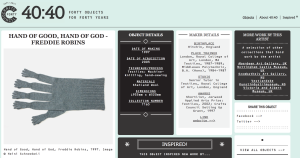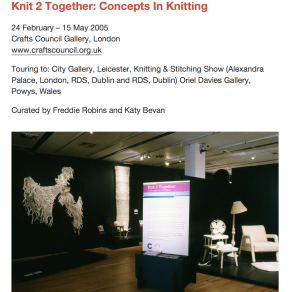A new exhibition, What Do I Need To Do To Make It OK?, features Freddie Robins and the arts of stitching and knitting, which reminded me of a review I wrote a decade ago, of an exhibition fanfaring the reinvention of knitting, Knit 2 Together at the Crafts Council Gallery.
Back in 2005, knitting was at the vanguard of the DIY/Maker Movement, and while that movement is going from strength to strength, the boom in all-things-knitted points to how commerce and the media can hitch a ride on even the most unlikely bandwagon. As I mention in the article, a decade ago yarn shops were closing. But now it can be argued that, along with other independent shops run by enthusiasts and local-entrepreneurs, crafting shops are spearheading a high street revival; while “public knitting” was once deemed radical, now it’s helping shopkeepers build communities (a “user group” even) with knitting circles that “keep the lights on” after closing time. Crafting events in libraries, schools and museums are guaranteed crowd-pleasers; Craft Fairs and Maker Faires draw in punters looking for unique items (which chain stores could ever supply), and all of this helps fund the freelance economy. Another knock on effect of knitting is the boost it has given publishing; from how-to books to anthologies of radical craft, publishers, magazines and newspapers are benefitting from the expansive-yarn-economy. And while it’s a decade since Design Week published my article, the message is still current; Susan Jones recently declared, “Our future is in the making” in The Guardian (19/3/15).
Going mainstream doesn’t mean that the rad/alt brigade isn’t also thriving; Cast Off’s Rachael Matthews & Co. are also Prick Your Finger, combining an online shop with a maker’s manifesto. Artists and designers are using the methods, materials and skills of craft disciplines but are broadened the remit of stitch/knit beyond self-referential explorations of “crafts” and into a wider context of research and gallery shows. These days Freddie is Senior Tutor in Knitted Textiles and Reader in Textiles at the RCA, and one of the five artists contributing to What Do I Need to Do to Make it OK?. Described as ‘an investigation into damage and repair, disease and medicine, and the healing and restoration of landscapes, bodies, minds and objects through stitch and other media’, the show here…
What Do I Need To Do To Make It OK?
Pump House Gallery
Battersea Park, London SW11
pumphousegallery.org.uk
27 August to 1 November 2015
And while one of my obsessions is sleuthing for traces of long-gone temporary exhibitions, hence the re-posting of excerpts from my own written “archive”, as I look for clues it’s likely that I’ll find other interesting stuff too. Finding Knit 2 Together on the RCA website’s research pages, revealed a (new to me) repository of practice-based research projects. One more Google and I discovered Freddie’s contribution to an online Crafts Council gallery, a selection of innovative craft since the halcyon 1970s. With a neat and accessible Graphic User Interface (GUI) that let’s you can chose a format and search by type, 40:40 Forty Objects for Forty Years is an invaluable research resource, combining a visual feast, layers of hyperlinked information and dynamic usability; this is Freddie’s contribution.
And, before I lose my thread, here’s that earlier exhibition…
Knit 2 Together: Concepts in Knitting
Crafts Council Gallery
44a Pentonville Road, London N1
24 February to 8 May 2005
“Spin a yarn”
by Liz Farrelly
Design Week
24 February 2005, pp.18-19
Standfirst: Liz Farrelly previews a Crafts Council exhibition that creates a new, provocative pattern for that long-forgotten pastime, knitting [BTW: the editorial team write the standfirst, I’d never suggest that knitting was obsolete!]
It’s 20 years since the Crafts Council last staged an exhibition about knitting. As one of the most enduring crafts – the Ancient Egyptians did it – and one of the world’s most popular activities, enjoyed from Iceland to India, it’s shocking to realise how severely the vagaries of fashion have affected knitting’s fortunes within the world of art, craft and design.
In its 1970s hippie-heyday of ‘constructed textiles’ the ball and sticks brigade enjoyed Fine Art credentials – think wall-hangings in corporate HQs. But in the designer decade knitting sunk back under the radar. Could it perhaps have something to do with knitting being thought of as ‘women’s work’?
Now knitting has come in from the cold and its ‘strictly granny’ image is gone forever. Witness the catwalk success of all things woolly, from Issey Miyake’s A-Poc inventions to Lainey Keogh’s lacy concoctions. Plus, knitting is now a lifestyle choice – cool in its extreme nerdy cosiness – a vanguard of the DIY design movement and an indicator of ‘nesting’ tendencies.
Reborn in the US (where craft shops and textile art still thrive), it’s reached ‘craze’ status, spawning colour supplement articles, shelves of publications oozing ‘alternative’ attitude and funky yarn stores hosting knit-clubs, where public knitting is regarded as a political act. With the demise of local yarn shops in the UK, and the majority of purchases now made on-line, Freddie Robins (co-curator of the Crafts Council show) surmises that group knitting, previously a private activity, is akin to ‘showing your knickers in public’. How subversive is that?
Spurred on by the Victoria and Albert Museum’s phenomenally successful ‘Craft Rocks’ event last year, staged by guerilla knitters, Cast Off, the Crafts Council commissioned artist Freddie Robins and editor Katy Bevan to curate Knit 2 Together, which opens this week. Focusing on 15 international practitioners, the variety of work they’ve selected is unprecedented. The exhibition design by Airside, which transforms the gallery into a darkly intimate space, complete with flexible/modular plinths, plays with this diversity, emphasising the interlocking nature of knitting while accommodating objects of vastly different scale.
Educated as a knitter, and a graduate of the Royal College of Art, where she teaches on the Mixed Media course, Robins uses her skills to make objects and installations exhibited in galleries and the environment. Asked to define knitting she leaves it wide open, describing it as ‘taking a single fibre and making it into something’. Robins has been collecting information on knitters of all persuasions ‘for years’. When asked to co-curate Knit 2 Together, she started out defining what it’s not.
‘The exhibition is not about the body or function; it’s about pushing the public’s perception of knitting beyond fashion and its image as a cosy craft, to being subversive and “out there”’, she says. ‘And additionally, we didn’t select work to fill a set of categories; every piece was chosen for quality’.
The selection is inclusive; from a French outsider artist to a recent RCA graduate; from work on an architectural scale to toy-making. What remains constant across all the pieces, however, is a sense of surprise and invention. Cuddly toys they may be, but Donna Wilson’s are surreal, angry, cannibalistic; it’s only a knitted balaclava, but when worn by Andy Diaz Hope in a busy financial district of a North American city the public may think a bank job’s in the offing; light and filmy though it is, a cobweb by Shane Waltener is gigantic enough to span a museum’s entrance-hall, evoking nightmare visions of a giant spider prowling the galleries.
Another not-to-be missed redefinition of the art of knitting is Kelly Jenkins’s machine-knit jersey ‘canvases’ featuring sensational tabloid headlines (‘Knitting Uncensored’) and phone-box sex-cards substituting the words ‘knit’ and ‘sex’, simultaneously confusing gender stereotypes and making you smile.
Robin’s own contribution to the exhibition resulted from an artist’s residency in Berlin, when her daughter was just six months old. ‘My hands were itchy to make something, but I was emotionally and physically exhausted, so I invented a way of working where I didn’t have to make decisions’. Robins inscribed the faces of a number of dice with a series of choices – colours, number of stitches, increase or decrease. ‘I could sit in bed at night, throw the dice, and the next day apply the instructions on a knitting machine’. The pieces are pure chance, highlighting the process of knitting rather than any end result. And although they’re pinned out as if to be sewn together, they could never add up to anything wearable. ‘If you’re not a knitter, though, you won’t recognise that reference and instead may read them as architecture, defining the space left between’, adds Robins.
As an exhibition that revels in rule breaking, highlights diversity and questions your assumptions, whether you’re a knit-head or a knit-novice, Knit 2 Together delivers.


